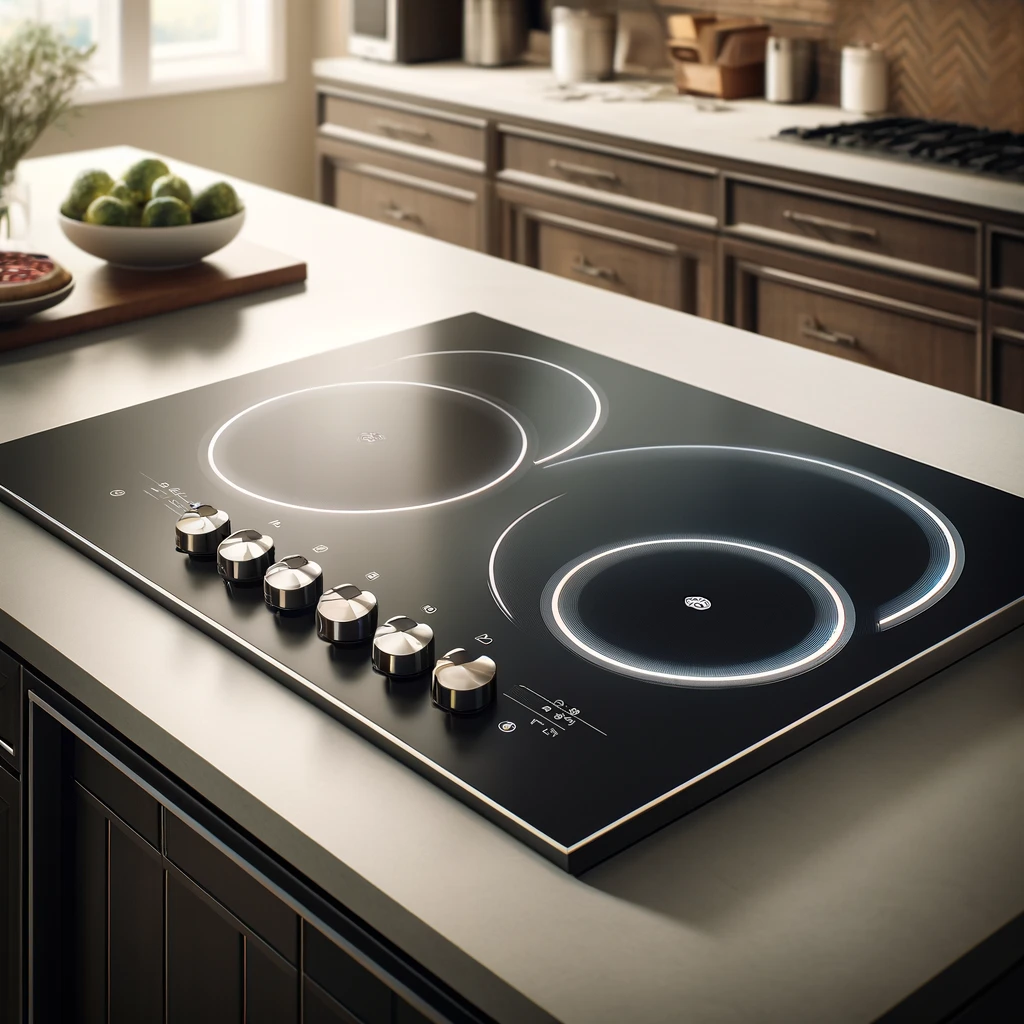
When it comes to choosing the right cooktop for your kitchen, the decision between induction vs electric cooktops can be a tough one.
In this article, we will explore the basics of induction and electric cooktops, compare their efficiency, cooking performance, safety features, installation requirements, cost analysis, durability, pros and cons and maintenance.
By the end of this post, you will have a better idea of which type of cooktop is the right fit for your kitchen.
Understanding the Fundamentals of Induction and Electric Cooktops
The table below does a comparison of some of the top Induction and Electric Cooktops in the market:
Induction Cooktop Option (Bosch 800 Series)
Electric Cooktop Option (GE 30 Inch)
Induction Cooktop Option (Samsung)
Electric Cooktop Option (Whirlpool 30-inch)
| Feature/Model | Induction Cooktop Option (Bosch 800 Series) | Electric Cooktop Option (GE 30 Inch) | Induction Cooktop Option (Samsung) | Electric Cooktop Option (Whirlpool 30-inch) | |||||
|---|---|---|---|---|---|---|---|---|---|
| Brand | Bosch | GE | Samsung | Whirlpool | |||||
| Cooking Zones | 4 | 4 | Flexible zone for large pots | 5 | |||||
| Power Levels | 17 power levels | Multiple settings with melt setting | Precise power control | 5 power levels | |||||
| Control Type | Touch control with AutoChef | Knob controls | Digital-LED display | Knob controls | |||||
| Special Features | FlexInduction® provides flexibility | Dual-ring element | Virtual Flame | Wi-Fi Connectivity | FlexHeat Triple Radiant Element | ||||
| Energy Efficiency | Very High (90% of energy goes to cooking) | Lower (70% energy efficiency) | Extremely high | Lower than induction but efficient | |||||
| Safety Features | Pan recognition | Child lock | Safety shutdown | Control lock | Hot surface indicator | Safety shutoff | Child lock | Warm zone element | Hot surface indicator |
| Installation | Professional installation required | Easier | can be DIY in some cases | Professional installation required | Easier | can be DIY | typically 220V | ||
| User Ratings | 5/5 (Highly rated for speed and safety) | 4/5 (Consistently well-rated) | 5/5 (Very highly rated for control) | 3/5 (Good ratings for easy cleaning and size) |
Induction and electric cooktops provide modern kitchens with versatile cooking methods, each harnessing different technologies to prepare meals.
The foundational difference between the two lies in how they generate heat and transfer it to the cookware. Induction cooktops utilize electromagnetic fields to directly heat pots and pans without heating the cooktop surface itself.
This method requires cookware to have a ferromagnetic base, such as cast iron or some stainless steels, to function. When an induction-compatible pot is placed on the cooktop, an electric current is passed through a coil beneath the glass surface, creating a magnetic field that induces an electric current in the pot, heating it up.
Electric cooktops, in contrast, operate by converting electrical energy into heat through resistive heating elements, either exposed coils or embedded beneath a ceramic glass surface.
When turned on, electricity flows through these elements, causing them to heat up. This heat is then transferred to the cookware placed on top of them.
Unlike induction, the cooktop’s surface heats up and transfers this heat to any cookware placed on it.
This process does not require specific types of pots or pans, making electric cooktops versatile in terms of cookware compatibility.
One of the immediate differences users may notice between the two is the cooktop’s response time.
Induction cooktops boast rapid adjustments in heat levels, allowing for precise control over cooking temperatures.
This responsiveness is due to the direct heating method of the cookware rather than the cooktop surface. On the other hand, electric cooktops may have a slower response to temperature adjustments, as the heating elements themselves must first increase or decrease in temperature, which is then transferred to the cookware.
Both technologies have evolved to offer a range of power settings and features designed to accommodate a variety of cooking techniques, from gentle simmering to rapid boiling.
The choice between induction and electric cooktops ultimately rests on the consumer’s priorities, including cooking habits, kitchen design, and budget considerations.
The Efficiency Factor: Induction vs Electric
When evaluating the energy efficiency of cooktops, induction models standout as remarkably efficient compared to their electric counterparts.
This efficiency is primarily due to the way induction cooktops generate and transfer heat directly to the cookware, substantially minimizing energy loss.
Unlike traditional electric cooktops that first heat the cooktop surface, which then transfers heat to the pot or pan, induction technology ensures that the energy is focused where it’s needed most – the bottom of the cookware.
This direct transfer of energy means that less heat is wasted into the surrounding environment, making induction not only more energy-efficient but also cooler to work around.
The efficiency of induction cooktops extends beyond just energy savings.
These cooktops are known for their rapid heating capabilities, allowing water to boil and ingredients to cook faster than on electric models.
This reduction in cooking time can further contribute to overall energy savings, as less time on the cooktop means less energy consumed.
Additionally, the quick cool-down feature of induction cooktops adds an extra layer of efficiency, as it reduces the risk of residual heat loss, unlike electric cooktops which may remain hot, and therefore energy-consuming, even after being turned off.
Furthermore, the precise control offered by induction technology allows for more efficient cooking.
Users can instantly adjust the temperature setting to exactly what is needed for the dish being prepared, minimizing the risk of overheating and thus wasting energy.
In contrast, electric cooktops might require guesswork in finding the perfect temperature setting, potentially leading to extended cooking times and additional energy use.
In summary, the efficiency factor heavily favors induction cooktops over electric ones due to their direct heat transfer, rapid heating and cooling capabilities, and precise temperature control.
These features not only contribute to a more energy-efficient cooking process but also enhance the overall cooking experience by saving time and reducing energy costs.
Cooking Performance and Control

The superiority of induction cooktops in terms of cooking performance and control is notable.
These units offer unparalleled precision when it comes to adjusting the temperature, making them ideal for delicate cooking tasks where maintaining a specific heat level is crucial.
Induction technology allows for immediate changes in temperature, giving cooks the ability to sear meats perfectly or simmer sauces without the risk of burning.
This is achieved through an electromagnetic field that directly heats the cookware, allowing for a quick response to temperature adjustments.
On the other hand, electric cooktops may struggle with distributing heat evenly across the cookware. This can lead to uneven cooking and hot spots, which are less than ideal when striving for perfectly cooked meals.
The nature of resistive heating elements means that changes in temperature take longer to manifest in the cookware, leading to a less responsive cooking experience.
While electric cooktops can still perform well for general cooking needs, they lack the finesse that induction technology offers.
Induction cooktops also shine in their ability to distribute heat more evenly.
The direct heating method ensures that the entire base of the cookware heats up at the same rate, reducing the likelihood of uneven cooking.
This is particularly beneficial when preparing dishes that require consistent temperatures, such as delicate sauces or chocolates that can easily seize or burn.
Moreover, the advanced technology of induction cooktops often includes features like precise temperature control settings and programmable cooking options.
These features further enhance the user’s ability to cook with accuracy, ensuring dishes are prepared exactly as intended every time.
The combination of rapid heating, even heat distribution, and precise temperature control makes induction cooktops a superior choice for those who prioritize cooking performance and control in their kitchen endeavors.
Installation and Compatibility Requirements
One of the crucial considerations when choosing between an induction and electric cooktop is the installation process and the compatibility requirements with your existing kitchen setup.
For electric cooktops, the installation process is relatively straightforward. These units can be plugged into a standard electrical outlet, and they’re ready to use with any cookware, making them a versatile option for many kitchens.
The simplicity of electric cooktops extends to their installation, which can often be performed without the need for professional help, provided there is an appropriate power outlet nearby.
On the other hand, induction cooktops come with specific installation and compatibility requirements that can influence your decision.
Firstly, they require a dedicated electrical circuit due to their high power consumption, which may necessitate professional installation to ensure that your kitchen’s electrical system can safely support the unit. Furthermore, the compatibility of cookware is a significant consideration with induction cooktops.
Because they use electromagnetic fields to heat the cookware directly, only pots and pans made of ferromagnetic materials like cast iron or certain types of stainless steel will work. This means you might need to invest in new cookware if your current set is not compatible.
Additionally, while the flat surface of an induction cooktop blends seamlessly into many modern kitchen designs, ensuring your countertop material and layout can accommodate the cut-out size needed for the cooktop is essential.
It’s worth measuring your available space and comparing it with the specifications of the induction cooktop you’re considering.
Considering these requirements, it’s clear that while induction cooktops offer advanced cooking capabilities and efficiency, they might also entail additional initial setup costs and considerations.
Electric cooktops, in contrast, offer ease of installation and universal cookware compatibility, making them a straightforward choice for many homeowners.
Understanding these nuances will help you align your kitchen capabilities and preferences with the right type of cooktop.
Safety Features and Considerations

Safety is a paramount concern in any kitchen, and when comparing induction to electric cooktops, there are distinct advantages and considerations to be mindful of for each type.
Induction cooktops stand out for their innovative safety features, primarily due to the way they generate heat. Since induction technology heats the cookware directly through an electromagnetic field rather than the cooktop surface itself, the risk of burns from touching the cooktop is significantly reduced.
This feature is particularly advantageous in households with small children or for individuals prone to kitchen accidents, as the cooktop surface remains relatively cool to the touch as long as there isn’t compatible cookware on it.
In contrast, electric cooktops generate heat through resistive elements under the ceramic surface or via exposed coils, which in turn heats any cookware placed on top.
This process results in the surface and the surrounding area becoming hot, posing a potential burn hazard if accidentally touched.
Even after the cooktop is turned off, the residual heat can linger, maintaining a burn risk until it completely cools down.
Another safety feature inherent to many induction cooktops is the automatic detection of cookware.
If a pot or pan is not detected on the cooktop, the unit will not activate, further minimizing unnecessary heat generation and energy waste.
Electric cooktops typically do not have this feature, relying instead on the user to turn them off manually when cooking is completed.
Both cooktop types often include additional safety features like child lock capabilities, preventing unintended activation, and automatic shut-off functions, which turn the cooktop off after a period of inactivity.
These features enhance the safety profile of both induction and electric cooktops but do not mitigate the fundamental differences in how their operational technologies influence kitchen safety.
Understanding these safety aspects is crucial for making an informed decision that aligns with your household’s needs and ensures a safer cooking environment.
Cost Analysis: Initial Investment vs Long-Term Savings
Navigating the financial implications of choosing between an induction and an electric cooktop involves more than just comparing price tags at the point of purchase.
Induction cooktops, known for their advanced technology and efficiency, generally command a higher initial cost.
This upfront investment covers not only the appliance itself but potentially additional expenses such as the need for compatible cookware and possibly upgrading kitchen electrical installations to accommodate the unit’s requirements.
These factors can add to the overall cost, making induction cooktops seem like a pricier option initially.
On the flip side, electric cooktops are typically more budget-friendly at the outset.
Their compatibility with all types of cookware and the absence of special installation requirements make them an attractive option for those looking to minimize upfront kitchen upgrade costs.
However, it’s essential to look beyond the initial purchase and consider the operational costs over time.
The efficiency of induction cooking can translate into significant energy savings in the long run.
By directly heating the cookware and offering precise temperature control, induction cooktops minimize wasted energy.
This efficiency can lead to lower utility bills, offsetting the higher initial investment over the appliance’s lifespan.
Additionally, the faster cooking times associated with induction cooktops can further contribute to energy savings, compounding the financial benefits over time.
In contrast, traditional electric cooktops may lead to higher energy consumption due to their less efficient heat transfer and longer cooking times.
While the lower initial cost is appealing, these factors can result in higher ongoing expenses, potentially making electric cooktops more costly in the long term.
When assessing the cost of induction versus electric cooktops, it’s crucial to weigh the initial investment against potential long-term savings.
Considering both the upfront and operational costs will provide a clearer picture of which cooktop offers the best financial advantage for your kitchen in the long run.
Durability and Maintenance
When it comes to the longevity and upkeep of induction and electric cooktops, several key factors set them apart.
Induction cooktops boast a design free of physical heating elements, relying instead on electromagnetic fields to heat cookware.
This absence of traditional elements significantly reduces wear and tear, enhancing the durability of these units.
The sleek, flat surface of an induction cooktop not only contributes to its modern aesthetic but also simplifies cleaning, as there are no crevices for food particles and spills to accumulate.
Electric cooktops, featuring either exposed coils or a smooth ceramic surface, can face challenges with durability over time.
The coils can become damaged or misshapen, and the ceramic surface is prone to scratching or, in extreme cases, cracking, especially if a heavy object is accidentally dropped on it.
These surfaces also require careful cleaning to avoid damage, and with coil versions, food and debris can collect in and around the elements, making them more cumbersome to maintain.
From a maintenance perspective, the ease with which an induction cooktop can be wiped down after use is a notable advantage.
Since the cooking surface remains cooler and heats only through contact with induction-compatible cookware, spills and splatters do not bake onto the surface as they might on an electric cooktop, which stays hot for a period after use.
For electric cooktops with a ceramic surface, special cleaners may be necessary to avoid scratching the surface, adding an extra step to the cleaning process.
Overall, the innovative design of induction cooktops minimizes physical deterioration and streamlines maintenance routines.
While electric cooktops have their own merits, they may present more challenges in terms of durability and ongoing upkeep, impacting their lifespan and performance in your kitchen.
The Verdict: Making the Right Choice for Your Kitchen
Deciding between an induction and an electric cooktop is a personal journey that hinges on individual needs, lifestyle, and financial considerations.
If the pinnacle of your kitchen dreams is to harness state-of-the-art cooking technology for unmatched efficiency and precision, then investing in an induction cooktop aligns with your aspirations.
Its ability to rapidly adjust temperatures and evenly distribute heat suits the avid cook looking to elevate their culinary creations.
The upfront cost may be higher, but the long-term savings on energy bills and the joy of enhanced cooking experiences often justify the initial expenditure.
Conversely, if your priorities lean towards practicality and affordability without the necessity for quick cooking times or specific cookware compatibility, an electric cooktop offers a solid solution.
It provides consistent performance suitable for everyday cooking demands without the added need for special installations or cookware investments.
Before making your final decision, weigh the pros and cons in light of your cooking habits, kitchen design, and financial flexibility.
Each cooktop style brings its own set of advantages to the table, and the best choice for you will blend seamlessly with your kitchen’s functionality and aesthetic, enhancing your cooking journey for years to come.
Whether you choose the advanced technology of an induction cooktop or the straightforward reliability of an electric model, your decision will pave the way for delightful culinary explorations in your home.
Related Articles:
Top Rated: Best Pots and Pans for Gas Stove
A Sneak Peek into the Features of the Best Dishwasher 2024
As an Amazon Associate, I earn commission from qualifying purchases



